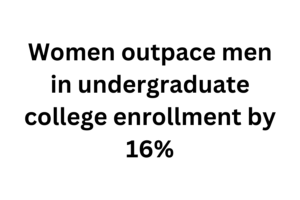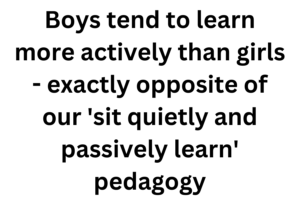
The Education Gender Gap: APA Task Force looks at How to Help Boys Succeed in School
The April/May, 2023 edition of the Monitor on Psychology, the bimonthly magazine of the American Psychological Association, led with a cover story about helping boys and young men succeed in the classroom (Abrams, 2023). The article was introduced with a bold statement: "At school, by almost every metric, boys of all ages are doing worse than girls." (p. 5). The author adds, "For boys of color, that gap is even larger." (p. 5).
Note: Educational achievement research is linked to the gender binary and continues to use female (girl, woman) and male (boy, man) as comparable groups in most research.
But First, Some Good News
 The graduation rate in the United States has been steadily increasing since 2002. According to the Brookings Institution, we have seen graduation rates rise consistently over past two decades - from a low of 71.7% in 2001 to a high of 85% in 2018 (Reeves et al., 2021), the last year data was aggregated. Both boys and girls have shown improvement, but girls have been expanding their educational achievements at a higher rate than boys across all levels of education.
The graduation rate in the United States has been steadily increasing since 2002. According to the Brookings Institution, we have seen graduation rates rise consistently over past two decades - from a low of 71.7% in 2001 to a high of 85% in 2018 (Reeves et al., 2021), the last year data was aggregated. Both boys and girls have shown improvement, but girls have been expanding their educational achievements at a higher rate than boys across all levels of education.
 An extensive meta-analysis by Voyer and Voyer (2014) found that girls perform better than boys academically across a wide variety of metrics. Girls and women are not only performing better in coursework, they are graduating high school at higher rates as well. According to the Brookings Institution, more females graduate from high school than males in all US states. The gap is significant too - from a low of about two percentage points in North Dakota to a high of nine in Mississippi. On average, 88% of girls graduate from high school, while 82% of boys do the same. If you consider there are about 4.2 million 17 years olds in any given year (Office of Justice Programs, 2020), the typical age of graduation, 250,000 girls and nearly 400,000 boys fail to graduate from high school every year.
An extensive meta-analysis by Voyer and Voyer (2014) found that girls perform better than boys academically across a wide variety of metrics. Girls and women are not only performing better in coursework, they are graduating high school at higher rates as well. According to the Brookings Institution, more females graduate from high school than males in all US states. The gap is significant too - from a low of about two percentage points in North Dakota to a high of nine in Mississippi. On average, 88% of girls graduate from high school, while 82% of boys do the same. If you consider there are about 4.2 million 17 years olds in any given year (Office of Justice Programs, 2020), the typical age of graduation, 250,000 girls and nearly 400,000 boys fail to graduate from high school every year.
Differences become even more apparent when examining graduation rates by race. On average, 89% of White students graduate from high school, while 79% of Black students do so, representing a 10-point difference. For Hispanics, the difference is 8 points, with an average graduation rate of 81% (Brookings.edu). These disparities also persist in college enrollment. For example, there is an 8% higher enrollment rate for Black women compared to Black men, and a 9% higher enrollment rate for Hispanic women compared to Hispanic men. Overall, women are enrolling in and graduating from higher education at higher rates than their male counterparts, and this trend holds true for both White women and women of color.
 Females are also making up an increased presence in traditionally male dominated professions requiring college and post-graduate training. According to NCES statistics, women outpace men in undergraduate college enrollment by 16%. This trend is seen in fields requiring post-graduate degrees as well.
Females are also making up an increased presence in traditionally male dominated professions requiring college and post-graduate training. According to NCES statistics, women outpace men in undergraduate college enrollment by 16%. This trend is seen in fields requiring post-graduate degrees as well.
For instance, the representation of women in the medical field has shown significant progress over the years. In 1981, only 24% of medical students were female, but this number doubled to 48% by 2019, as reported by the Association of American Medical Colleges (AAMC, 2023).
Similarly, the field of psychology has also witnessed notable changes in gender representation. In 1975, women accounted for only 30% of psychologists with PhDs (Willyard, 2011). By 2007, the percentage of women in psychology had increased to 57%, and it rose to 70% in 2019. According to the APA's Center for Workforce Studies, women comprised 76% of new psychology doctorates in 2011 (Willyard, 2011), indicating their growing presence in the field. Recent anecdotal data suggests that the gender gap in psychology continues to widen. Unfortunately, amidst these advancements, it is concerning that salaries for psychologists and psychology faculty have consistently declined (APA, 2011).
 Law schools are also seeing increased female enrollment and graduation. In 2016, the number of women enrolled in Juris Doctorate [JD] programs across the United States passed 50% and reached 54% in 2020. Regarding education, according to the National Center for Education Statistics [NCES], (nd), females earned about 61% of Associate degrees, 58% of the Bachelor's degrees, 64% of Master's degrees, and 56% of educational Doctorates.
Law schools are also seeing increased female enrollment and graduation. In 2016, the number of women enrolled in Juris Doctorate [JD] programs across the United States passed 50% and reached 54% in 2020. Regarding education, according to the National Center for Education Statistics [NCES], (nd), females earned about 61% of Associate degrees, 58% of the Bachelor's degrees, 64% of Master's degrees, and 56% of educational Doctorates.
While the article shares that both males and females are advancing when it comes to education, it also points out areas where we could do better, particularly for boys. Because of this, the APA task force is looking at shared interests and learning styles to help develop new approaches to helping boys succeed in the classroom. They hope to counter the long term trend of boys falling behind girls in school and the recent expansion of this education gender gap.
Boys in the Classroom
Overall, we have seen steady gains in educational attainment over the past couple of decades, and this is true for both girls and boys. But according to the APA article, boys in school are underperforming compared to girls on nearly all metrics (Abrams, 2023). This is not a recent trend, however. Voyer and Voyer (2014) found that girls have consistently outperformed boys, based on academic marks and grades, since 1914 - but the gap seems to be getting larger in recent years.
 While the author points out that not all boys are struggling and that not all girls are thriving in our education system, they share some concerning statistics about the challenges boys, and especially boys of color, face that hinder their academic success. For example, boys are disciplined (punished) more than girls and are diagnosed with learning disabilities at higher rates than girls. They are at a higher risk for inattention and hyperactivity and tend to learn more actively than girls - exactly opposite of our 'sit quietly and passively learn' pedagogy. These issues certainly impact boys' academic achievement and lead to lower graduation rates. According to Voyer and Voyer (2014), while high school graduation is achieved by 89% of girls, boys graduate at a rate of only 82%.
While the author points out that not all boys are struggling and that not all girls are thriving in our education system, they share some concerning statistics about the challenges boys, and especially boys of color, face that hinder their academic success. For example, boys are disciplined (punished) more than girls and are diagnosed with learning disabilities at higher rates than girls. They are at a higher risk for inattention and hyperactivity and tend to learn more actively than girls - exactly opposite of our 'sit quietly and passively learn' pedagogy. These issues certainly impact boys' academic achievement and lead to lower graduation rates. According to Voyer and Voyer (2014), while high school graduation is achieved by 89% of girls, boys graduate at a rate of only 82%.
Voyer and Voyer (2014) suggest this is not a new crisis for boys, but rather an ongoing trend that continues to worsen. In 2020, the Society for the Psychological Study of Men and Masculinities (APA Division 51) launched a Task Force for Boys in School (TFBS) consisting of psychologists, sociologists, and educators. Their goal is to investigate obstacles and challenges faced by boys that hinder their academic success and to make recommendations to help inform decisions at all levels of education.
Abrams (2023) details four major points highlighted by the task force as they move closer to their final product. You can read the full article and get all the details about the task force and their work at https://www.apa.org/monitor/2023/04/boys-school-challenges-recommendations.
First, in most areas boys and men are improving but at a lower rate than girls and women. In some areas boys and men are declining.
Second, the task force recommends understanding differences in how boys and girls learn and to find opportunities to engage with them individually and build relationships.
Third, based on this understanding, the task force provides recommendations on reimagining the classroom to bring out boys' strengths (e.g., their tendency to prefer hands-on activities). They also provide suggestions for exploring gender roles and masculinity and how these impact learning.
Fourth, while some are advocating for starting boys in school a year later than girls, due to developmental differences between the sexes, the research is not conclusive. The task force argues that rather than waiting a year, actually starting school earlier (e.g., preschool, headstart) is better. This is especially true if they focus on skills that will improve learning and educational achievement in later years - such as social-emotional regulation, rule following, and delaying gratification, among others.
 The Task Force is only about half way through their larger goal of developing specific recommendations, and these will likely expand on those discussed already to include skills that help boys and men succeed as well as making larger systemic changes to our education pedagogy (specific to child learners) and andragogy (specific to adult learners). It looks like we may get updates along the way and can expect their final report and recommendations.
The Task Force is only about half way through their larger goal of developing specific recommendations, and these will likely expand on those discussed already to include skills that help boys and men succeed as well as making larger systemic changes to our education pedagogy (specific to child learners) and andragogy (specific to adult learners). It looks like we may get updates along the way and can expect their final report and recommendations.
Here are some links if you want to learn more:
Monitor on Psychology Cover Story (April/May, 2023): Boys are Facing Key Challenges in School by Zara Abrams. (Additional recommended readings are included at the end of the article)
APA Division 51, Society for the Psychological Study of Men and Masculinities
APA Division 51 Task Force on Boys in School
Brookings Institution Video: Why Men and Boys are Struggling, by Richard Reeves
Brookings Institution Book: Of Boys and Men, by Richard Reeves
References
Abrams, Z. (2023, April/May). Supporting boys' success in the classroom. Monitor on Psychology, 46-53. American Psychological Association. Available online at https://www.apa.org/monitor/2023/04/boys-school-challenges-recommendations
American Psychological Association [APA] (2010). Psychology salaries decline. Retrieved from https://www.apa.org/monitor/2010/04/salaries
Association of American Medical Colleges [AAMC] (2019). Diversity in medicine: Facts and figures 2019. Retrieved from https://www.aamc.org/data-reports/workforce/data/figure-12-percentage-us-medical-school-graduates-sex-academic-years-1980-1981-through-2018-2019#:~:text=Similar%20to%20the%20trend%20mentioned,47.9%25%20of%20graduates%20were%20female
National Center for Educational Statistics [NCES] (nd). Degrees conferred by race/ethnicity and sex. Retrieved from https://nces.ed.gov/fastfacts/display.asp?id=72
National Center for Educational Statistics [NCES] (2019). Indicator 20: Undergraduate enrollment. https://nces.ed.gov/programs/raceindicators/indicator_reb.asp
Reeves, R. V., Buckner, E., & Smith, E. (2021). The unreported gender gap in high school graduation rates. Brookings Institution. Retrieved from https://www.brookings.edu/blog/up-front/2021/01/12/the-unreported-gender-gap-in-high-school-graduation-rates/
Voyer, D. & Voyer, S. D. (2014). Gender differences in scholastic achievement: A meta-Analysis. Psychological Bulletin, 140(4), 1174-1204. Retrieved from https://www.apa.org/pubs/journals/releases/bul-a0036620.pdf
Willyard, C. (2011). Men: A growing minority? Retrieved from https://www.apa.org/gradpsych/2011/01/cover-men#:~:text=Data%20from%20APA's%20Center%20for,influx%20of%20women%20as%20well